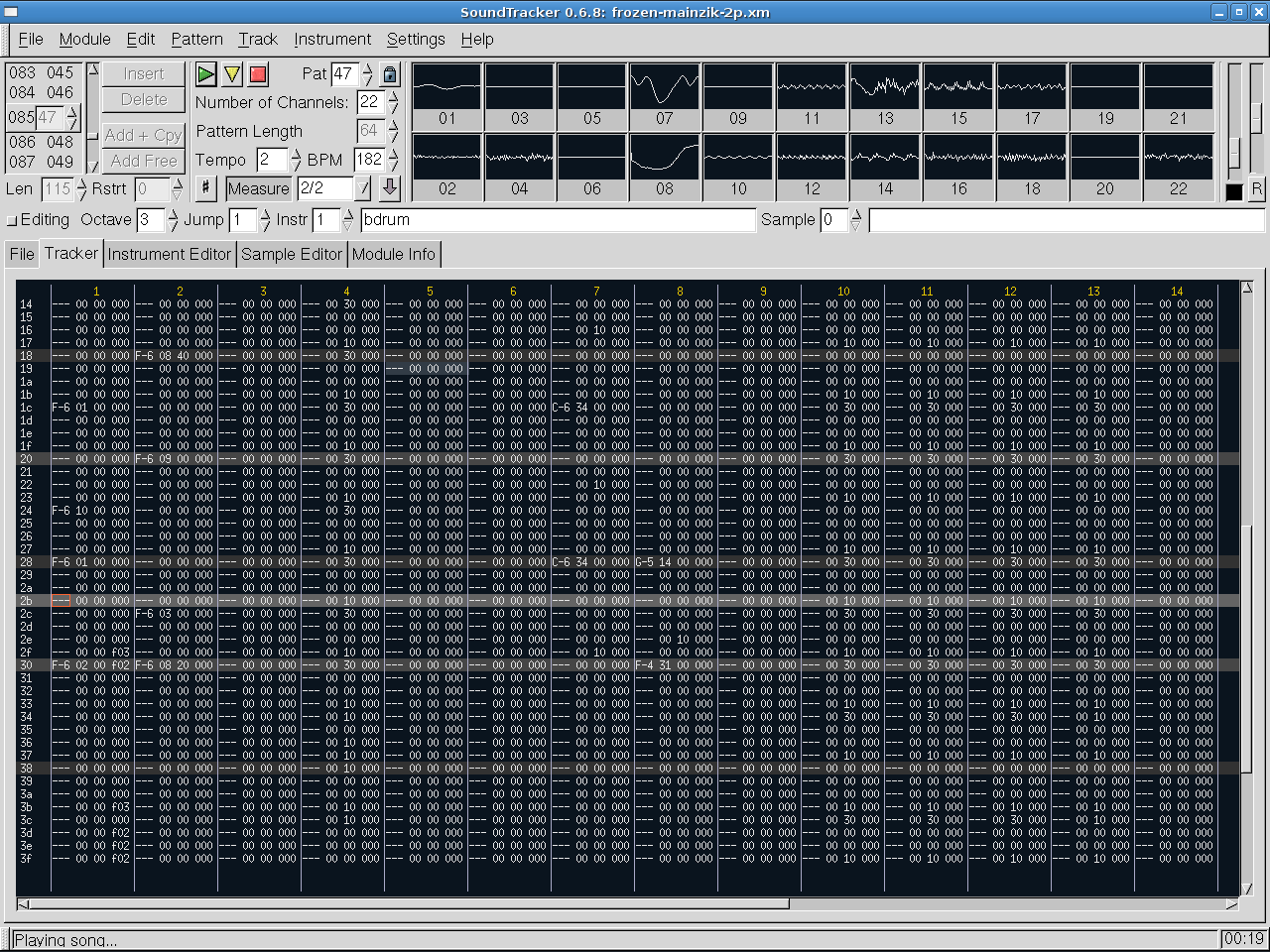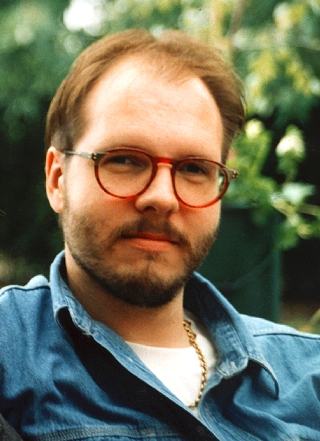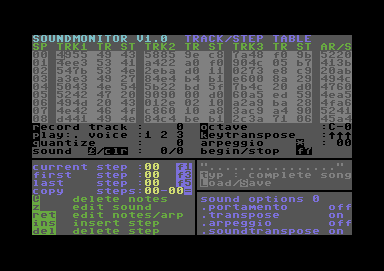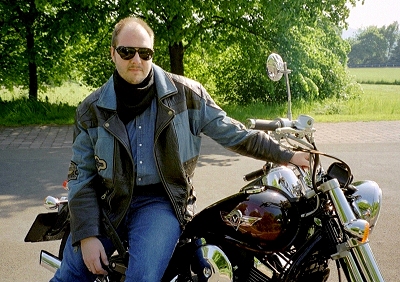Note: Cet article (et les suivants de cette série) sont écrits en anglais, pour la simple raison que mes sources, tant directes qu’en ligne, sont anglophones.
Par ailleurs, dans certains de ces articles, il me semble que j’ajoute du contenu original/rarement vu au corpus de connaissances, donc autant faire en sorte que cela profite au plus grand monde 🙂
My previous article on Soundtracking1In French in ze texte. was all about passion and nostalgia: presenting a couple of great Amiga demos, playing a handful of notable Amiga modules, and explaining my understanding of how soundtracking worked — you know, the whole « notes as a sequence of letters instead of solfege symbols » thing2 Or, « A#3 > 🎶 », which incidentally is the name of Elon Musk & Grimes’ next child.

This is a Unix version of Soundtracker, from February 2006.
(to hear this specific song, click here and press the Return key)
Today I’m starting a series of articles which is no less about passion and nostalgia, but tries to go further behind the curtains, and talks about the ones who made soundtracking possible: Mr. Obarski of course, but also those who inspired him (and those who, in turn, inspired them3Spoiler alert: It’s turtles all the way down!).
Eventually, my intent is to find out when the « tracker » way of composing music (or, the music sequencer) made the jump from a hardware, physical product to a software product. Who was the first one to dream up coding that interface? Is it really Karsten Obarski, father of the Sountracker? I want to find out.
So let’s start with the culmination of all these inspirations.
Let’s start where this little « quest » of mine started.
(drumroll)
Karsten Obarski,
elusive legend
Karsten Obarski programmed the Ultimate Soundtracker tool for Amiga 1000 in the Summer of 1987, and released it through German software publisher EAS in December 1987.
He was 22. It was his first ever completed program. He initially wrote it to write his first music, for the first game of a friend of his, Guido Bartels.
Ultimate Soundtracker was the first musical program to mix the tracker format with audio samples (instead of synth sounds), and thus was a tremendous success… in terms of number of tools which stole the whole idea and built upon it, that is. While quite cheap4It cost 99 Deutsche Marks from 1988, which is equivalent to 50€ in 2025., it failed commercially.
Some say it failed due to a temperamental behavior (= it crashed all too often)5Although the author of that text has since dismissed it.. Or maybe it’s because the target customers, musicians, were not interested in that way of composing. Most probably, it’s because the code was quickly cracked and shared for free… We’ll see about that.

The first version published by reLine/EAS was version 1.21, from December 1987.
Which part of your song are you going to start with? Melody, or percussions?
Despite its apparent failure, it gave birth to a host of clones (and a name to its own genre of tools), each building upon the previous clone’s improvements.
In March 1988, just 3 months after the initial commercial release of Ultimate Soundtracker, coder The Exterminator/TJC (Netherlander Mark Langerak) released Soundtracker II under his own name (removing Obarski’s full credit, shy of a mention).
Exterminator had de-assembled the original program and released the resulting source code, along with its playroutine6A piece of code that makes it possible to easily integrate a Soundtracker song (or « module ») into any program. This allowed anyone to not only create music in the tracker format (fine), but they could also freely (as in, illegally) use that format in their own production (games and demos).

I stole this picture from 56k.es, who probably built it from the images in this EAB thread.
While it was illegal to share the playroutine for free, this was the needed spark to trigger the Cambrian explosion of trackers: before long, several other clones appeared. Just for 1988, Amiga musicians witnessed the successive releases of Soundtracker Pro I, TJC Soundtracker I, Soundtracker III and IV, DOC Soundtracker (11 versions in 88), Master Soundtracker, and many others. Check out this graph!
Some would say it was « fair game » for a software that wasn’t successful, and felt abandoned. From Pex « Mahoney » Tufvesson, coder of another clone named Noisetracker:
« The basic idea of Soundtracker was delightful, but unfortunately there were some serious bugs and other shortcomings. I tried to contact Karsten Obarski with bug reports, but was told that he was not going to do anything about it and that Soundtracker was not a commercial success. Today it would be classed as abandonware, but at the time it was just frustrating. »
Pex Tufvesson took matters into his own hands and disassembled the entire program. After much effort, he had the entire assembly code for Soundtracker on his desk. He fixed the bugs, increased the number of samples from 15 to 31, and released Noisetracker 1.0 on August 1, 1989. However, this first version also contained some bugs, so version 1.1 was released just a week later.
Techworld interview (automatic English translation)
Abandoned? Truth be told, Karsten Obarski didn’t last long in « the scene » (of which he was never a part of anyway).
He did release a couple more versions of Ultimate Soundtracker, including v2.0 in October 1988 which implemented (and thus made official) the famed « module » or MOD format. That file format, created in July 88 by the DOC Soundtracker IX clone (coded by Unknown/DOC, aka Michael Kleps7Update from December 2022: See this interesting thread by Thomas Cherryhomes about how the MOD format was introduced.), combined note patterns with audio samples into a single file.
And then, as Keyser Söze would say, « Poof, he was gone ». No more updates to Ultimate Soundtracker. He was not heard of anymore on the Amiga, as far as I know. Barely a year had gone by since the initial release of his groundbreaking tool.

From Aktueller Software Markt (ASM) magazine, May 1991.
He kept working on games for a bit, specifically for the reLINE publisher, for which he composed the music of the game « Dyter-07 » 8For which he created another tool: « I wrote an completely new tool named « Synthpack » which used sampled audio for
percussions only and realtime generated synthetic sounds for the melodic voices. It sounded more like an old 64 which I like very much. ». Then, by 1993, it seems he left the computer world for good.
What’s left of him is a legacy, both in terms of composing process, but also in terms of « sound »: Ultimate Soundtracker was accompanied by the legendary ST-01, a sound disk, which contained audio samples which Obarski ripped from his own synthesizers 9Check out this audio comparison between the ST-01 samples and the original synthesizer sounds., and which came to define the early sound of the Amiga.
Obarski himself provided the template: Ultimate Soundtracker came with several complete demo songs, showing that the man also had a knack for melodies. Amegas, Crystalhammer, Endtheme, Bluesong, Blueberry, etc.: Titles that bring nostalgic stars to the eyes of any kid from these days 🙂
The man behind the legend

Picture taken from AMP, dated probably 2000-2005.
Not much is known about Karsten Obarski, really. Only a couple of interviews are available online.
Let’s dive in, and find out what brought him to create Soundtracker!
The two main interviews are:
- The one on the Amiga Music Preservation site (date: unknown, but most probably around 2005), with pictures!
- …and the one from the now-defunct AM/FM disk-mag (date: 1992, since he says he was 27 years old at the time).
In addition to that, there are a few sources here and there, for instance a biography on the VGMPF wiki, a since-deleted page on Wikipedia from 2008 (now forwarding to the Ultimate Soundtracker page); the since-lost Karsten Obarski Tribute Project, with a short message from The Man himself in 2001; … and that’s it! If you know of more, I’m interested 🙂
So, from these interviews, what can we learn?
What made you start programming the SoundTracker?
A short time after that I [moved] to the Amiga I realized that everyone used large sample loops instead of coding music.
AM/FM interview
I couldn’t understand why no-one used samples as instruments. So I sampled a few sounds from my Yamaha DX21 and programmed my first music routine.
How did you get the idea of creating Soundtracker?
AMP interview
A friend of mine (…) asked me if I could write some music for him (…). At that time I had already experimented around with a playroutine on my brand new Amiga (…)
So I begun to code a simple-to-use editor to generate the data to be used by my playroutine. After some improvements, my Soundtracker was born.
Sounds like it came out of thin air!
But let’s look at the question right before this one:
Which composing programs have you been using?
AMP interview
In the times of the « 64 »10Commodore 64., I’ve used Chris Hülsbeck’s « Soundmonitor » to implement some music-tunes in my codings.
Ah ha! That’s interesting. So, Karsten Obarski had a Commodore 64 before he bought an Amiga 1000, and on that C64 he discovered Soundmonitor, which… is a tracker-style program from 1986, the year before Obarski wrote and released his own Ultimate Soundtracker!

Indeed, while it’s much less easy on the eye, we can see similarities: channels (three, in that case, marked TRK for « tracks »), line positions on the left sidebar (SP for « song position » I guess, or maybe « step »?), and more settings.
Browsing other sources, we find that this is the same conclusion reached by others. For instance, in his book « Bits and Pieces: A History of Chiptunes« , author Kenneth B. McAlpine writes:

Peter Moormann goes one step further in his book « Music and Game: Perspectives on a Popular Alliance« :

French blog Geekzone treads the same waters in their article « The little-known history of trackers » 11In French in ze texte., but goes one step further: author and audio producer Jean-Christophe « Faskil » Detrain relates that, for purists, Hülsbeck’s Soundmonitor was the first necessary step, but Obarski’s Soundtracker was indeed the first real tracker — because to said purists, a real tracker has to use audio samples, not synth sounds.

I say ‘real’ because for purists, since Sound Monitor doesn’t use samples (but rather the audio synthesis of the internal SID chipset), it isn’t really considered to be a 100% pure tracker. The debate is open. As far as I’m concerned, C64 wins. »
Still, to Faskil, « C64 wins »: the first tracker is indeed Soundmonitor.
Looks like Karsten Obarski took inspiration from Chris Hülsbeck, contributing a nicer interface around the tracker format and most importantly sample playback, along with a fourth channel12Thanks to Paula, the Amiga sound chip, which was more advanced in that matter than the C64’s SID chip., right?
Ergo, that would make Chris Hülsbeck the real father of music trackers?
It’s not quite that simple. Turns out, Hülsbeck got inspiration somewhere too — of course.
But before we dive into Chris Hülsbeck’s own inspirations for Soundmonitor, let’s try to understand another aspect of Karsten Obarski’s legend: after releasing such an important piece of software, why did he disappear all of a sudden, vanishing without a trace? Let’s answer the title of this article.
After releasing a key software product, Karsten Obarski more or less disappeared, never to be heard again of in the game music (or demo music) world. Why so, and where is he now?
The answer to « Why did he left? » can be found by mixing various sources.
I was very proud to have invented a milestone program.
The data structure of my MOD files even still lives today on PCs and all other music programs, after they ripped parts of my program and modified my playroutine as well.
But say – how many people who know about « trackers » and modules also know their roots? Who knows me? That’s only a few of them.
AMP interview, adapted.
I would like to thank (…) all those who care about the young but forgotten history of computing, with all these great guys.
AMP interview, adapted.
When and why did you give up the SoundTracker project?
After I’d sold my copyrights to a company named EAS for a few bucks, and the Soundtracker clones started to come from all directions, I didn’t have the inspiration to code any more on that program.Did you feel bad when other people stole your idea/program?
(…) It wasn’t funny when people made some patches on the SoundTracker and then thought of it as their own program, removing my name completely.
Even today’s trackers work in that same way, and still use the tone-event data structures which I invented. (Which is a very simple one.)Do you have anything to say to the programmers of new trackers?
AM/FM interview.
Just try to find new ways by yourself and do not spend so much time making the same things others have done before you.
So, by the looks of it, he wasn’t too happy with the situation, and decided it was time for him to find a new hobby.
Now, « where is he now? », you might ask me, and I’m glad you did. Again, we resort to the available interviews…
Are you still active in the scene these days?
I now have a job as an electronic-specialist at an industrial company. Sometimes I program a little bit at our circuit-board testing machines – that’s fun enough for me 😉The other free time I like to spend with my wife, my motorbikes, my old house, my synthesizers and my very few left friends.
AMP interview.
Indeed, while desperately looking for anything resembling an online presence of Karsten Obarski, the closest I could find was an empty account on the Tinkercad website. Tinkercad is a free tool to create 3D models of, amongst other things, circuit boards. We can only guess that he was trying it out for fun…
(Edit in 2023: the Tinkercad account has since been deleted)
But [music is] still just a hobby – and in the Summer my wife and I often prefer to ride with our motorbikes [rather] than sitting in the house.
KOTP website, adapted.
So there you have it. Our hero, proud of his accomplishment and eager to try something else, left the Amiga town, riding his motorcycle into dawn…

Goodbye, you legend. Goodbye.
Lacking direct interaction with Karsten Obarski himself (and believe me, I tried to track him down, or to find at least an email address), this is the best I can do. Karsten, if you read this, please contact me 🙂
Let’s move on to Obarski’s apparent inspiration for Soundtracker, then, in order to find out, in turn, his inspiration.
So, Soundmonitor was created by Chris Hülsbeck. This name might ring a bell to old-timers: he scored such well-known games as Turrican and Turrican II, Apidya, R-Type, etc. Unlike Obarski, he did not disappear, but kept very active in the gaming music scene, even producing several of his own albums (and royalty free music) and orchestra versions of the Turrican music.
All this from writing an audio tool on the C64 on 1986, probably as a teenager? Nice!
We could dive into the numerous interviews of him online, sure.
But, just in case, let’s try and ask him directly!

He seems to be very busy, I doubt he’ll ever answer…
5 hours later:

So that’s going to be the topic for the next part of this series 🙂
See you soon!
Other articles in this series:
- Soundtracking sur Amiga : passion, explications et exemples — The Twitter thread that started it all (in French).
- Soundtracker origins, part 1: Where in the World is Karsten Obarski? — About Karsten Obarski, author of The Ultimate Soundtracker.
- The origin of Soundtracker’s MOD format — When you see a Twitter thread with key information, it is your duty to preserve it.
- Soundtracker origins, part 2: Welcome to Turrican, aah hahahaha — About Chris Hülsbeck, author of Soundmonitor.
- Soundtracker origins, part 3: Facing a stone mountain — About Karl Steinberg, author of MIDI Multitrack Sequencer.
- Soundtracker Origins, interlude: The coders behind the Cambrian explosion — Where I get to interview a few key people in the Soundtracker saga.